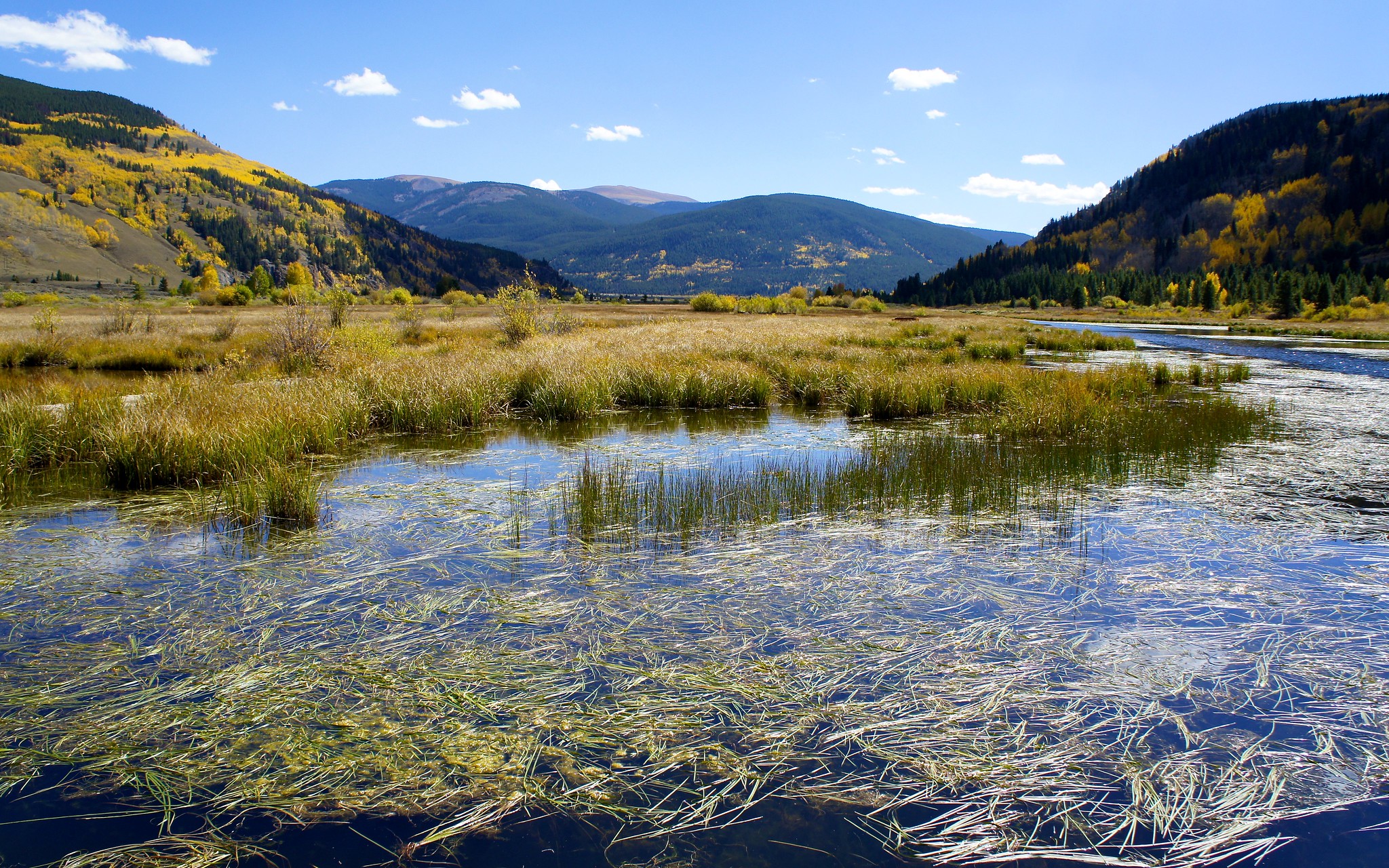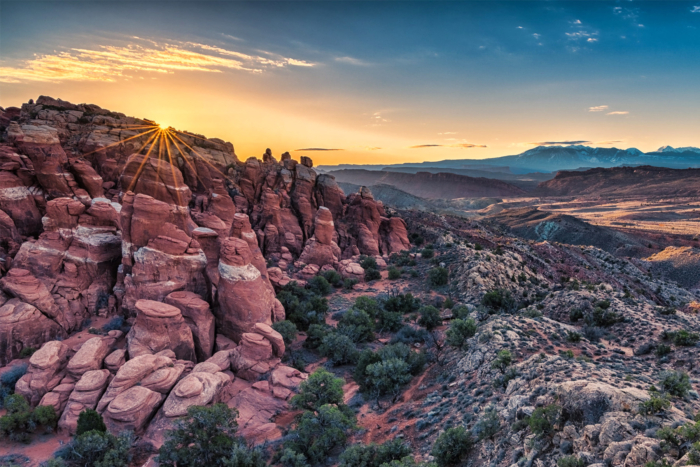There are 130 National Monuments in the U.S., every one featuring spectacular views of unique landscapes, hiking, camping, and thinner crowds than you’ll find at higher-profile National Parks.
But there is only one National Monument where you can see thousands and thousands of dinosaur fossils sticking out of the Earth-like roots, where you can hike to ancient petroglyphs, and camp in two different states without even leaving the park.
Dinosaur National Monument is, without a doubt, one of the most unique National Monuments in the country. Established in 1915, it spans 210,000 acres across the northern Utah-Colorado border. It was created to protect the massive trove of dinosaur bones discovered in the area in 1909.
Today over 250,000 people visit Dinosaur National Monument every year to hike and camp among a landscape that feels utterly prehistoric.
Molly Swindle has been working as a Park Guide at Dinosaur for 4 years, learning about fossils, giving talks and presentations to guests, answering an unending stream of questions, and exploring the trails and campsites on a daily basis. She’s the expert on this place.
Which was why GearJunkie got ahold of her to talk about the best hikes, camping spots, and all her tips/tricks for visiting the Monument.
Hiking in Dinosaur National Monument

Within the monument are 13 hiking trails to explore (five on the Colorado side and eight in Utah). They range from easy to difficult. Although most of them are easy to moderate and are less than 4 miles in length.
“My personal favorite hikes are the Harpers Corner Trail and the Jones Hole Trail,” Swindle said.
She explained that Harpers Corner Trail is a 2-mile easy-to-moderate hike that only gains 100 feet of elevation. It’s at the very end of Harpers Corner Road, one of two paved scenic drives in the monument. Swindle said there are no dinosaur bones on this side of the park. But the hike is a cool one and leads to a picturesque vista.

“[The viewpoint] gives you some nice sweeping views of the canyons below,” she said. “And there are some marine fossils that are visible in the rock under your feet when you’re looking down at the canyons, which is pretty neat.”
Her other favorite trail, Jones Hole Trail, is one of two hikes in Dinosaur National Monument that is closer to 9 miles and is a little bit harder. This trail gains 400 feet of elevation and covers 8.5 miles round trip. It’s a beautiful hike she said, but it’s a haul to get there. Which also means it’s far less trafficked.
“It’s out in the boonies a little bit. You have to drive about an hour and a half, one way, from the quarry visitor center where the dinosaur bones are,” Swindle said. But the hike offers beautiful views of the Utah desert and even includes a short loop to Ely Creek Falls.
Jones Hole trail follows a babbling brook through the basin of a canyon and terminates at the Green River. Jones Hole Creek is a great spot for fishing, according to the National Monument website (although a current Utah state Fishing license is required).

More Popular Hikes
Of course, the most popular trail in Dinosaur National Monument is the Fossil Discovery Trail. It’s a moderate, 1.2-mile hike (2.4 miles out and back) in Dinosaur National Monument that cuts through several tilted rock layers and passes three distinct fossil areas. At the Morrison Formation stop, guests can see fragments of fossils and several bones in exactly the same place where they were discovered by Earl Douglass in 1909.
Swindle also mentioned the Sound of Silence and Desert Voices Trails, both of which are short, moderate hikes that have incredible views and geologic diversity. The Hog Canyon and Box Canyon Trails are great for families with small children, and Plug Hat Trail is also short (0.25 miles) and easy (with virtually no elevation gain).
Then, the Gates of Lodore Trail takes visitors right to the edge of the Green River, with a dramatic view of the entrance to Lodore Canyon.

The longest and most challenging hike in the park is Ruple Point. This trail gains 600 feet of elevation over 4.6 miles (9.2 miles round trip), winding through sagebrush, juniper trees, and a pinyon forest. It pops out at a breathtaking viewpoint, 2,500 feet above the Green River, looking down Split Mountain Canyon.
And, if you have pets, you’re in luck — kind of. Three of the 13 trails in Dinosaur National Monument are pet-friendly: Swelter Shelter Trail, Plug Hat Butte Trail, and River Trail.
Camping in Dinosaur National Monument

While there is no dispersed camping in the Monument or “Boondocking” as Swindle called it, there are six established front country campgrounds and one backcountry campground for backpackers who want to get a little deeper into the Monument.
The six campgrounds (Gates of Lodore, Spirit River, Split Mountain, Echo Park, Rainbow Park, and Deer Lodge) have over 120 total sites to choose from. You can reserve some of the sites ahead of time on the Dinosaur National Monument campground website, or upon arrival on a first-come, first-served basis.

“[Green River and Split Mountain] are our main campgrounds here on the Utah side of the park. They’re not very far from the dinosaur bones. So that’s where most people will camp,” Swindle said.
If you want to get away from most people though, try checking out the other campsites that are a little further from the main attractions. Deer Lodge Campground and Gates of Lodore Campground are smaller, with just 22 and seven campsites, respectively. But they are far less frequented, as they are located pretty deep in the monument.
Backpacking in Dinosaur National Monument

Backcountry backpacking in the Monument is not very popular, according to Swindle. The main challenge is access to water. There isn’t much of it in that desert environment. So you have to carry a lot of H2O with you or plan strategically so you can fill up at campgrounds or creeks along the way. And, because the park is home to black bears, all backcountry users have to practice bear safety along their way.
There is one designated backcountry campsite, however. And it is pretty popular.
“That’s called the Ely Creek Site. That one does have to be reserved in advance by calling the park and trying to get a reservation,” said Swindle. Securing a reservation at Ely Creek can be a challenge, especially during peak season as it’s a favorite among the area’s locals.
But, she said, “It’s a really nice way to kind of ease yourself into backpacking if you haven’t done it before because it has more amenities than a typical backcountry site.”
The Ely Creek site has water, a vault toilet, and a bear locker to store your food. It’s located along the Jones Hole Trail.
To enter the backcountry in Dinosaur National Monument, you will need to obtain a permit from the Visitor’s Center (or call 435-781-7700 to make a reservation). They’ll ask for your name and the number of people in your group, contact information, dates of your trip, the location where vehicles will be parked, vehicle descriptions and license plates, and the approximate locations of campsites for each night in the backcountry.
Tips and Tricks for Dino Monument

Check Conditions, Prepare Accordingly
First and foremost, check the conditions before you visit. Swindle said the website keeps current conditions up to date on a daily basis, and it helps prepare for what to expect.
In early spring (especially after a heavy winter), some of the trails and campgrounds might not be accessible. Checking the website is the best way to keep an eye on those kinds of closures. This year was an exceptionally wet winter, which means trail closures might last a little longer than usual.
That also means there will be a lot of water in the ground and runoff in the streams. So prepare for lots of bugs this spring and summer, Swindle said. “But on the bright side,” she added, “the flowers are going to be spectacular.”

Navigate Carefully, Stay Aware
Swindle also recommended double and triple checking your GPS maps when trying to navigate to Dinosaur National Monument beforehand. GPS doesn’t work very well in National Monuments like Dinosaur.
“A lot of times the GPS is trying to [direct people] where it says the name [of the Monument] on the map, which is like dead-center in the middle of the park,” Swindle said. “Here, [GPS] would try to put you in the river.”
And, when you’re driving on the roads keep your eyes open for reptiles, Swindle said. Particularly around dusk and dawn, snakes and lizards like to use the asphalt to gather heat and energy when the sun isn’t up. Sadly, that means a lot of them get run over by cars. So obey speed limits, and stay aware anywhere you drive in the park.
And for that matter, keep your eyes open for snakes on the trails and in the campgrounds as well. Rattlesnakes are not an uncommon sight in Dinosaur National Monument.
Ask a Ranger or a Guide
Finally, Swindle said that guests should never hesitate to ask Rangers or Guides questions. They are walking encyclopedias of knowledge and information regarding the Monuments, and people don’t take advantage of their expertise as much as they should.
“Just talk to them if you have questions about anything, because that’s literally what we’re here for,” Swindle said.
What to Bring

Water is the number one thing to make sure you have enough of at all times when in the Monument, said Swindle. It gets very hot and very dry in that area, and dehydration happens faster than most people realize.
Aside from that, the camping checklist for Dinosaur National Monument is much the same as it is for any other camping trip. You’ll want to bring a sleeping bag, a sleeping pad, a tent or car camper, a backpack, hiking shoes, a hat, food and snacks, and water. Did we mention water? Bring extra water.
And sunscreen is a wise addition to the list, too. There’s nothing that will spoil a good camping trip faster than a high desert sunburn.











